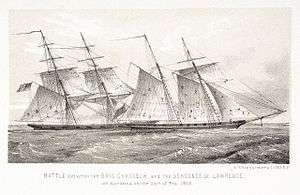HMS St Lawrence (1813)
 Chasseur capturing HMS St Lawrence, by Adam Weingartner | |
| History | |
|---|---|
| Name: | HMS St Lawrence |
| Acquired: | 13 June 1813 |
| Captured: | 26 February 1815 |
| General characteristics | |
| Class and type: | 14-gun schooner |
| Tons burthen: | 244 bm[1] |
| Complement: | 60 in British service |
| Armament: |
|
HMS St Lawrence was a 14-gun schooner of the Royal Navy. She had been built in 1808 in St. Michaels, Talbot County, Maryland for Thomas Tennant and sold to Philadelphians in 1810.[2] During the War of 1812 she was the American privateer Atlas. The British captured her in 1813 and renamed her St Lawrence. The American privateer Chasseur recaptured her in 1815, and then HMS Acasta re-recaptured her.
Privateer
The Atlas had a home port of Philadelphia and took to sea early in the war under the command of Captain David Maffitt. She was armed with 12 short 9-pounders and one long 9-pounder, and had a crew of 104 men. In July 1812, she cleared the Capes of the Delaware, and when two days out she took the brig Tulip, Captain Monk, just out from New York. On 5 August Atlas captured the Pursuit, of 450 tons, carrying 16 guns and a crew of 35 men, and the Planter, of 280 tons, carrying 12 12-pounders and a crew of 15 men. Both ships were thirty days out from Surinam, bound for London, with a cargo of coffee, cotton, cocoa, and six hundred hogsheads of sugar. Atlas, which had sailed between the two vessels and fired broadsides from both sides, had been damaged in the fighting before the two vessels struck. Still, Atlas and her two prizes made it safely back to Philadelphia.[3][4]
On a cruise early in the summer of 1813, Atlas took shelter in Ocracoke Inlet, North Carolina, where she found the 18-gun privateer Anaconda, out of New York City, Captain Nathaniel Shaler commanding. Here, on 12 July, a British squadron under Rear Admiral Sir George Cockburn, that included HMS Highflyer, herself a former American privateer, captured the two vessels.[5] The British took both vessels into service, Anaconda as HMS Anaconda, and Atlas as HMS St Lawrence.[6][7]
British service
Her first British commander was Lieutenant David Boyd and he served on her until 1 October 1814, when he became acting commander of the sloop Alban, which too was a former American privateer, the William Bayard.
In June 1814 St Lawrence, was part of a squadron under Captain Robert Barrie of the 74-gun Third Rate Dragon. The British chased Joshua Barney's Chesapeake Bay Flotilla of 18 gunboats, barges and the like up the Patuxent River. On 26 June, the Americans scuttled 16 of the remaining vessels of the flotilla, with the British capturing one.
St Lawrence shared with a number of other British warships in the capture, on 2 July 1814, of the schooner Little Tom.[8] Then 12 days later, St Lawrence shared in the capture of the schooners William, Eliza, Union, and Emmeline.[8][Note 1]
In January 1815 Lieutenant James E. Gordon took command.[1] On 26 February 1815, St Lawrence was bound for Mobile with dispatches when just off Havana,[10] she encountered the privateer brig Chasseur, out of Baltimore and under the command of Captain Thomas Boyle.
Chasseur carried 14 guns and 102 men, while St Lawrence carried 14 guns and 76 men, though the St Lawrence's broadside was much heavier. What would prove decisive though was small arms fire from the American vessel.[10] The intense action lasted only about 15 minutes, during which St Lawrence suffered six men killed and 18 wounded, several of them mortally.[1] (According to American accounts, the English had 15 killed and 25 wounded.) Chasseur had five killed and eight wounded, including Boyle. Both vessels were badly damaged. Captain Boyle made a cartel of St Lawrence and sent her and her crew into Havana as his prize.[11]
Fate
Acasta recaptured St Lawrence in March.[12] The British sailed St Lawrence to Bermuda where an Admiralty Court ruled that as the capture took place after the treaty of peace, in accordance with the terms of peace she was to be returned to the United States as a legitimate prize of war.[13]
Notes, citations, and references
- Notes
- Citations
- 1 2 3 Winfield (2008), p.368.
- ↑ Footner (1998), 111
- ↑ Maclay (1899), 251-254.
- ↑ Coggeshall (1856), 79-80.
- ↑ The London Gazette: no. 16770. pp. 1746–1747. 4 September 1813.
- ↑ Maclay (1899), pp.261-262.
- ↑ James (1859), pp.95-96.
- 1 2 The London Gazette: no. 17206. p. 11. 4 January 1817.
- ↑ The London Gazette: no. 17209. p. 89. 14 January 1817.
- 1 2 Hepper (1994), pp.152-3.
- ↑ Maclay (1899), pp.295-300.
- ↑ Gossett (1986), p.95.
- ↑ Viele (1996), p.79.
- References
- Coggeshall, George (1856) History of the American privateers, and letters-of-marque, during our war with England in the years 1812, '13, and '14. Interspersed with several naval battles between American and British ships-of-war. (New York).
- Footner, Geoffrey M. (1998) Tidewater triumph: the development and worldwide success of the Chesapeake Bay pilot schooner. (Mystic, Conn.: Mystic Seaport Museum).
- Gossett, William Patrick (1986) The lost ships of the Royal Navy, 1793-1900. (London:Mansell). ISBN 0-7201-1816-6
- James, William (1859) The naval history of Great Britain, from the declaration of war by France in 1793 to the accession of George IV. (London : Richard Bentley).
- Maclay, Edgar S. (1899) A History of American Privateers. (New York).
- Viele, John (1996) The Florida Keys: True stories of the perilous straits. (Sarasota, Fla.: Pineapple Press).
- Winfield, Rif. British Warships in the Age of Sail, 1793-1817: Design, Construction, Careers and Fates. Seaforth Publishing, 2nd edition, 2008. ISBN 978-1-84415-717-4.
